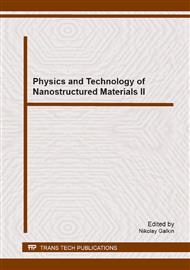[1]
A.K.M. Nurul Amin, Titanium Alloys. Towards Achieving Enhanced Properties for Diversified Applications, InTech, Rijeka, (2012).
DOI: 10.5772/1928
Google Scholar
[2]
C. -E. Hu, Z. -Y. Zeng, L. Zhang, X. -R. Chen, L. -C. Cai, D. Alfè, Theoretical investigation of the high pressure structure, lattice dynamics, phase transition, and thermal equation of state of titanium metal, J. Appl. Phys. 107 (2010).
DOI: 10.1063/1.3407560
Google Scholar
[3]
Y. Hao, J. Zhu, L. Zhang, J.Y. Qu, H. Ren, First-principles study of high pressure structure phase transition and elastic properties of titanium, Solid State Sci. 12 (2010) 1473-1479.
DOI: 10.1016/j.solidstatesciences.2010.06.010
Google Scholar
[4]
V.Z. Bengus, E.D. Tabachnikova, V.D. Natsik, I. Mishkuf, K. Chakh, V.V. Stolyarov, R.Z. Valiev, Low-temperature deformation and fracture of bulk nanostructural titanium obtained by intense plastic deformation using equal channel angular pressing, Low Temp. Phys. 28 (2002).
DOI: 10.1063/1.1528580
Google Scholar
[5]
V.A. Moskalenko, A.R. Smirnov, A.V. Moskalenko, Cryomechanically obtained nanocrystalline titanium: microstructure and mechanical properties, Low Temp. Phys. 35 (2009) 905-907.
DOI: 10.1063/1.3266928
Google Scholar
[6]
H.R. Hajiyani, M. Jafari, Magneto optical properties of β.
Google Scholar
[100]
titanium nanowires, J. Magn. Magn. Mater. 324 (2012) 418-423.
Google Scholar
[7]
Y. -J. Chen, J. -H. Hsu, H. -N. Lin, Fabrication of metal nanowires by atomic force microscopy nanoscratching and lift-off process, Nanotechnology 16 (2005) 1112.
DOI: 10.1088/0957-4484/16/8/020
Google Scholar
[8]
J.S. Lehtinen, T. Sajavaara, K. Yu. Arutyunov, M. Yu. Presnjakov, A.L. Vasiliev, Evidence of quantum phase slip effect in titanium nanowires, Phys. Rev. B 85 (2012) 094508.
DOI: 10.1103/physrevb.85.094508
Google Scholar
[9]
P. Hohenberg, W. Kohn, Inhomogeneous Electron Gas, Phys. Rev. 136 (1964) B864.
DOI: 10.1103/physrev.136.b864
Google Scholar
[10]
X. Gonze, B. Amadon, P. -M. Anglade, J. -M. Beuken, F. Bottin, P. Boulanger, F. Bruneval, D. Caliste, R. Caracas, M. Cote, T. Deutsch, L. Genovese, Ph. Ghosez, M. Giantomassi, S. Goedecker, D.R. Hamann, P. Hermet, F. Jollet, G. Jomard, S. Leroux, M. Mancini, S. Mazevet, M.J.T. Oliveira, G. Onida, Y. Pouillon, T. Rangel, G. -M. Rignanese, D. Sangalli, R. Shaltaf, M. Torrent, M.J. Verstraete, G. Zerah, and J.W. Zwanziger, ABINIT: First-principles approach to material and nanosystem properties, Comput. Phys. Commun. 180 (2009).
DOI: 10.1016/j.cpc.2009.07.007
Google Scholar
[11]
M. Fuchs, M. Scheffler, Ab initio pseudopotentials for electronic structure calculations of poly-atomic systems using density-functional theory, Comput. Phys. Commun. 119 (1999) 67-98.
DOI: 10.1016/s0010-4655(98)00201-x
Google Scholar
[12]
H.J. Monkhorst, J.D. Pack, Special points for Brillouin-zone integrations, Phys. Rev. B 13 (1976) 5188.
DOI: 10.1103/physrevb.13.5188
Google Scholar
[13]
G.J. Martyna, M.E. Tuckerman, D.J. Tobias, M.L. Klein, Explicit reversible integrators for extended systems dynamics, Mol. Phys. 87 (1996) 1117-1157.
DOI: 10.1080/00268979600100761
Google Scholar
[14]
M. Eriksson, Licentiate thesis, Stockholm University, Stockholm, (2007).
Google Scholar
[15]
X. Huang, Y.I. Chumlyakov, A.G. Ramirez, Defect-driven synthesis of self-assembled single crystal titanium nanowires via electrochemistry, Nanotechnology 23 (2012) 125601.
DOI: 10.1088/0957-4484/23/12/125601
Google Scholar


